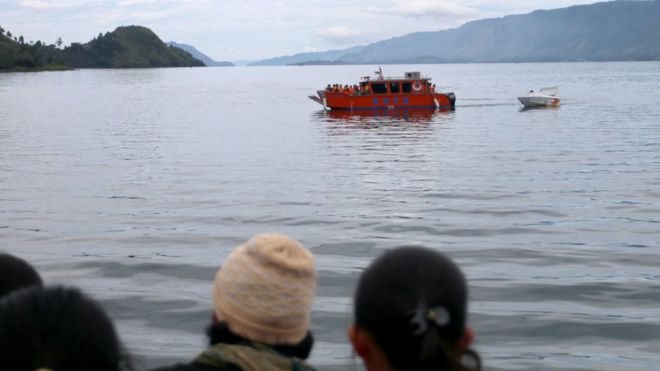Liputan6.com, Jakarta - Memasuki hari ketiga, Tim SAR Gabungan yang terdiri dari Basarnas, Marinir, dan kepolisian terus mencari para korban kapal tenggelam di perairan Danau Toba, Sumatera Utara, Senin sore, 17 Juni 2018.
Hasilnya, petugas menemukan sejumlah barang milik penumpang. Seperti uang, dompet, tas, telepon selular, helm, jaket, hingga drum plastik.
Selain medan yang sulit, kemampuan daya selam para personel dan alat (pendeteksi) terbatas membuat Tim SAR belum berhasil menemukan korban lainnya.
Dinginnya air Danau Toba juga menjadi kendala bagi penyelam, sehingga daya selam dibatasi sedalam 50 meter dari titik kedalaman yang berkisar 200 meter lebih.
Saat ini, Tim SAR baru menemukan 21 penumpang, yang terdiri atas tiga korban tewas dan 18 orang selamat. Dilansir dari Antara, ketiga korban tewas adalah Tri Suci Wulandari (24) asal Aceh Tamiang, Fajryanti (74) warga Binjai, dan Indah Juwita Saragih (22), warga Kecamaran Sidamanik, Kabupaten Simalungun.
Kini, baik korban tewas dan selamat KM Sinar Bangun dibawa ke RSUD Tuan Rondahaim di Pematang Raya, Kabupaten Simalungun, untuk penanganan lebih lanjut.
Sejumlah investigasi kini tengah dilakukan pihak kepolisian dan Kementerian Perhubungan (Kemenhub). Hingga sampai akhirnya mereka menemukan kejanggalan atau hal aneh terkait karamnya kapal KM Sinar Bangun di Danau Toba.
1. Nakhoda Tembak
:strip_icc():format(jpeg):watermark(liputan6-media-production/assets/images/watermarks/liputan6/watermark-gray-landscape.png,-0,0,0)/liputan6-media-production/medias/2253788/original/093290200_1529429121-IMG-20180619-WA0048.jpg)
Pencarian dan pertolongan korban tenggelamnya KM Sinar Bangun melibatkan lima tim utama berkekuatan besar dengan tugas berbeda. (foto: Liputan6.com / Reza Perdana)
Ternyata istilah sopir tembak tidak hanya berlaku pada kendaraan roda empat atau dua saja. Kapal KM Sinar Bangun juga memakai nakhoda tembak.
Kejanggalan ini berhasil terkuak saat nama nakhoda KM Sinar Bangun tidak terdaftar sebagai korban selamat maupun hilang. Setelah ditelusuri, dia masih berada di darat.
Siapa nama nakhoda tersebut, Kapolres Simalungun AKBP Marudut Liberty belum bersedia membeberkan identitasnya. Begitu pun dengan sang nakhoda tembak yang membawa KM Sinar Bangun tenggelam di Danau Toba.
Sementara, sang nakhoda asli KM Sinar Bangun berinisial TS. Dia merupakan warga Desa Simarmata, Kecamatan Simanindo, Kabupaten Samosir. Kepada polisi, TS mengaku meminjamkan kapalnya kepada seseorang untuk membawa penumpang.
"Saat ini TS masih kita amankan. Kita tidak bisa memberitahu di mana keberadaannya. Kalau kita beritahu, bisa menimbulkan hal yang tak diinginkan bersama. Kita masih terus melakukan pemeriksaan terkait peristiwa ini," katanya.
2. Kelebihan Muatan
:strip_icc():format(jpeg)/liputan6-media-production/medias/2254518/original/075890000_1529483720-20180620-Tim-SAR-Lanjutkan-Pencarian-Korban-KM-Sinar-Bangun-di-Danau-Toba-AP-3.jpg)
Tim SAR menggunakan teropong saat proses pencarian korban KM Sinar Bangun di Danau Toba, Sumatra Utara, Rabu (20/6). Sebelumnya, KM Sinar Bangun yang mengangkut 128 penumpang tenggelam di Danau Toba pada Senin (18/6) sore. (AP/Binsar Bakkara)
Sebelumnya diberitakan kapal KM Sinar Bangun yang tenggelam di Danau Toba membawa kurang lebih 80 penumpang.
Dalam kondisi cuaca sekitar yang cukup berkabut, kapal kayu itu berlayar dari Pelabuhan Simanindo, Kabupaten Samosir, menuju Tigaras Parapat, Kabupaten Simalungun.
Namun, setelah musibah terjadi, tersiar kabar jika jumlah penumpang yang tenggelam mencapai ratusan orang. Hal ini didasarkan dari laporan warga yang merasa keluarganya ikut dalam pelayaran kapal nahas tersebut.
Apakah itu artinya kapal kelebihan muatan? Ya. Karena dari versi polisi setelah melihat sertifikat KM Sinar Bangun, kapal kayu itu hanya bisa menampung 40 penumpang.
Versi berbeda diungkapkan oleh pihak Kementerian Perhubungan (Kemenhub). Kapal dengan ukuran 35 Gross Tonnage (GT) tersebut hanya bisa mengangkut sebanyak 43 orang.
Namun, pada kenyataannnya kapal KM Sinar Bangun membawa hampir 200 orang ditambah dengan puluhan kendaraan.
3. Data Manifest Simpang Siur
:strip_icc():format(jpeg)/liputan6-media-production/medias/2253544/original/000187400_1529399670-20180619-Danau-Toba-3b.jpg)
Anggota keluarga melihat daftar korban tenggelamnya KM Sinar Bangun di Danau Toba, Sumatera Utara, Selasa (19/6). Pencarian dan upaya penyelamatan dilakukan oleh Tim Gabungan Basarnas, Marinir dan kepolisian. (Jon NST/AFP)
Jumlah penumpang KM Sinar Bangun yang tenggelam di Danau Toba hingga kini masih belum pasti. Karena setelah diselidiki, kapal kayu itu tidak memilik data manifes yang memuat data penumpang.
Terkait hal ini Menteri Perhubungan Budi Karya Sumadi menduga, kapal tersebut merupakan kapal ilegal yang berlayar tanpa izin.
Karenanya, Kabag Pensat Divhumas Mabes Polri Kombes Pol Yusri Yunus membuka posko untuk mendata korban berdasarkan laporan masyarakat.
Pascamusibah tenggelamnya kapal kayu tersebut, ada 178 orang atau keluarga yang melapor telah kehilangan keluarganya ke posko pengaduan yang sudah dibuat datanya.


